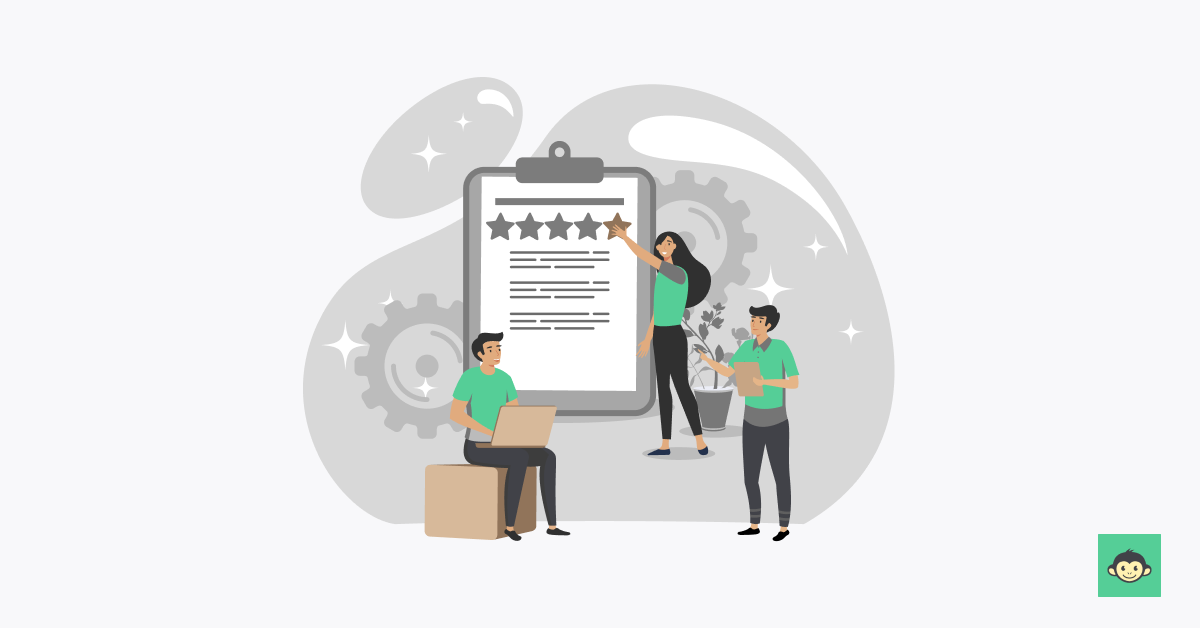Employee engagement and retention: Top strategies and 50+ survey questions to try in 2024

The ability to retain skilled and motivated employees is not just a matter of stability; it's a key determinant of long-term success. And at the heart of this success lies a powerful secret: employee engagement.
But what exactly is the relationship between employee engagement and retention? Simply put high levels of engagement act as a potent antidote to the all-too-common problem of employee turnover.
Organizations that prioritize and cultivate employee engagement reap the benefits of increased productivity, improved morale, and decreased attrition rates.
Let’s uncover the key factors that contribute to employee engagement, and how they intertwine with the retention strategies organizations can implement.
Table of contents:-
- Why is employee engagement important?
- What is employee engagement and retention?
- How does employee engagement impact retention?
- Importance of implementing employee retention strategies for your organization
- Why is employee retention important?
- How to measure employee engagement and retention kpi?
- What are the 5 key factors that drive retention?
- What role does leadership play in fostering both employee engagement and retention?
- 7 Strategies to increase employee retention and engagement
- Workplace employee engagement and retention activities
- How can remote work and hybrid work models impact employee engagement and retention?
- 50+ Employee engagement and retention questionnaires for your next pulse survey
- Top 5 employee engagement and retention statistics
- How can an employee engagement platform help you measure and improve retention?
- FAQs
Why is employee engagement important?

Employee engagement is crucial for several reasons. Firstly, engaged employees are more committed to their work and demonstrate higher levels of productivity and performance. They are motivated to go above and beyond, resulting in better outcomes for the organization.
Secondly, engaged employees are more likely to stay with the company, reducing turnover rates and associated recruitment costs.
Thirdly, employee engagement fosters a positive work environment, leading to higher morale, collaboration, and innovation. It enhances job satisfaction and overall well-being, which in turn improves employee retention and attracts top talent.
Ultimately, a highly engaged workforce translates into improved organizational success, customer satisfaction, and profitability.
What is employee engagement and retention?

Employee engagement refers to the emotional connection, commitment, and involvement an employee has toward their work and the organization. Engaged employees are passionate about their job, motivated to contribute their best efforts, and aligned with the company's goals and values.
They feel a sense of fulfillment and derive meaning from their work, resulting in higher levels of productivity, performance, and job satisfaction.
Retention, on the other hand, refers to the ability of an organization to retain its employees over a certain period. It measures the extent to which employees choose to stay with the company rather than seek employment elsewhere.
Employee retention is influenced by various factors such as job satisfaction, growth opportunities, work-life balance, compensation, and organizational and company culture.
While engagement focuses on the level of commitment and emotional connection employees have with their work, retention emphasizes the ability of the organization to retain valuable talent.
Both employee engagement and retention are crucial for organizational success as they contribute to productivity, continuity, and the development of a positive work environment.
How does employee engagement impact retention?

Employee engagement has a significant impact on retention within an organization. When employees are engaged, they develop a strong connection to their work and feel valued and appreciated.
This sense of fulfillment and purpose increases their overall job satisfaction, making them more likely to stay with the company.
An engaged employee is motivated to contribute their best efforts and go above and beyond their job requirements. They feel a sense of loyalty and commitment to the organization, which reduces their inclination to seek opportunities elsewhere.
Moreover, engaged employees tend to have higher levels of job involvement and satisfaction, leading to a stronger desire to remain in their current roles.
A good employee engagement strategy also fosters a positive company culture. Engaged employees often experience better relationships with their colleagues and supervisors, as well as a sense of camaraderie and belonging.
This supportive atmosphere can further enhance their commitment to the organization, improve employee retention, and reduce the likelihood of turnover.
Furthermore, engaged employees are more likely to perceive growth and development opportunities within the company. You can witness how engaged employees are motivated to expand their skills, take on new challenges, and advance in their careers.
When organizations invest in employee development and provide avenues for growth, they not only promote employee engagement strategies but also increase the likelihood of retaining top talent.
Overall, employee engagement positively impacts retention by fostering job satisfaction, loyalty, commitment, and a supportive work environment.
By prioritizing employee engagement initiatives, organizations can create a culture that attracts and retains talented employees, leading to improved retention rates and long-term success.
Importance of implementing employee retention strategies for your organization

Implementing employee retention strategies is of utmost importance for any organization. Here are several key reasons why focusing on employee retention strategy is crucial:
Cost savings
High employee turnover can be financially draining for organizations. Recruitment, hiring, and training new employees require significant resources. By implementing retention tactics, such as competitive compensation, meaningful career development opportunities, and a positive work environment, organizations can reduce turnover and save on recruitment and training costs.
Productivity and continuity
Retaining experienced employees helps maintain productivity and ensures continuity in operations. When employees stay with an organization for an extended period, they become familiar with its processes, systems, and culture, leading to increased efficiency and effectiveness. Retaining talented employees also minimizes the disruption caused by knowledge gaps when employees leave.
Institutional knowledge and expertise
Employees who have been with an organization for a longer duration accumulate valuable institutional knowledge and expertise. This knowledge is essential for maintaining and improving organizational processes, customer relationships, and product/service quality.
Retention techniques, such as mentorship programs and knowledge-sharing initiatives, facilitate the transfer of knowledge from experienced employees to newer ones, ensuring its preservation within the organization.
Employee engagement and morale
When employees feel valued and supported by their organization, their engagement and morale increase. Implementing retention strategies that foster a positive work culture, recognize and reward achievements, and provide opportunities for growth and development helps create motivated employees and a committed workforce. Employees engaged at work are more likely to go above and beyond, contributing to higher productivity and customer satisfaction.
Enhanced employer brand
Organizations that prioritize employee retention build a positive reputation as an employer of choice. A strong employer brand attracts top talent and reduces recruitment efforts. When potential candidates perceive an organization as committed to employee well-being and growth, they are more likely to apply for positions and remain with the organization long-term.
Customer satisfaction
Employee turnover can have a direct impact on customer satisfaction. When customers interact with knowledgeable and experienced employees who understand their needs, it leads to better service and stronger customer relationships.
By retaining employees, organizations can provide consistent and high-quality customer experiences, resulting in increased customer loyalty and positive word-of-mouth.
Innovative problem-solving
One often overlooked benefit of employee retention strategies is the potential for innovative problem-solving. Long-term employees develop a deep understanding of the organization's challenges and opportunities. This familiarity enables them to approach problems from a unique perspective, drawing on their accumulated knowledge.
With a stable workforce, these employees feel more comfortable proposing and testing unconventional solutions, leading to creativity and breakthroughs that can drive the organization forward.
Adaptability and resilience
Employee retention isn't just about maintaining the status quo; it's about building a workforce that can adapt and thrive in changing environments. When employees stay for the long haul, they become more resilient to shifts in the industry or market trends.
Their institutional memory helps the organization navigate uncertainties and challenges more effectively, as they remember past strategies and outcomes. This adaptability enhances the organization's agility and ability to seize new opportunities.
Cohesive team dynamics
Employee retention strategies contribute to the development of cohesive team dynamics. As employees stay and collaborate over time, they better understand each other's strengths, work styles, and communication preferences. This familiarity enhances teamwork and reduces conflicts, leading to smoother collaboration and improved project outcomes.
Long-standing team members create a sense of stability that fosters trust and camaraderie, enabling teams to work cohesively even in high-pressure situations.
Leadership pipeline
Implementing employee retention strategies nurtures the organization's leadership pipeline. Employees who stay and grow within the company often progress into leadership roles. These internal promotions ensure that leaders understand the organization's values, culture, and operations.
Additionally, promoting from within sends a powerful message to other employees about growth opportunities, motivating them to stay and advance their careers within the organization. Developing leaders internally is cost-effective and provides a more seamless transition into leadership positions.
By prioritizing employee retention, organizations can build a stable and talented workforce, fostering growth and success in a competitive business environment.
Why is employee retention important?

You see, employee retention isn't just a fancy buzzword; it's a powerhouse of benefits that can transform your workplace into a thriving hub of success. Here's why it's so darn important:
First off, let's talk money. High employee turnover can turn your budget into a rollercoaster. The cost of recruiting, hiring, and training new employees can add up faster than you can say "cha-ching." By focusing on retention, you're saving precious dollars and conserving valuable time and resources.
Think about it: experienced employees are like your organization's walking, talking encyclopedias. They know the ins and outs, the quirks and nuances. When they stick around, you're retaining a treasure trove of institutional knowledge that can keep your operations running smoothly.
But it's not just about efficiency – it's about a happier, more engaged workforce. When employees feel valued and supported and see a clear path for growth, they're more likely to give their all. That means higher productivity, better customer service, and an overall happier workplace.
Employee retention is the cornerstone of a thriving workplace culture where experienced employees serve as invaluable assets, holding the key to organizational success. Retaining seasoned staff members means preserving a wealth of institutional knowledge that keeps operations running smoothly and efficiently.
It cultivates a positive atmosphere where morale is high, and teams are cohesive, fostering collaboration and boosting productivity. This continuity also fuels innovation and creativity, as long-standing employees feel empowered to think outside the box and contribute novel ideas.
A stable workforce enhances the company's reputation, signaling to potential recruits that it's a place where talent is valued and nurtured. Employee retention is about fostering a culture of loyalty, growth, and fulfillment, where employees are not just working for a paycheck but are invested in the organization's journey towards success.
And let's not forget about your company's reputation. A revolving door of employees doesn't exactly paint a pretty picture. On the flip side, a reputation for valuing and retaining talent is like a magnet for top-notch candidates.
Ultimately, employee retention isn't just about holding onto people; it's about nurturing a culture of loyalty, growth, and fulfillment. It's about creating an environment where employees aren't just working for a paycheck but are genuinely invested in your organization's journey.
How to measure employee engagement and retention kpi?

Employee engagement and retention KPIs – it's like gauging the pulse of your organization! Here's how you can effectively track and analyze these crucial metrics:
Regular surveys and feedback:
- Administer surveys that delve into employee sentiments and satisfaction.
- Ask questions about their work experience, growth opportunities, and overall engagement.
- Honest feedback gives you valuable insights into what's working and what needs improvement.
Turnover rates and tenure analysis:
- Keep an eye on turnover rates – the number of employees leaving the organization.
- Compare this data to how long employees tend to stay (tenure analysis).
- High turnover rates or short tenures might signal engagement or retention issues.
Exit interview insights:
- When employees leave, conduct exit interviews to understand their reasons.
- Are there common themes or concerns? Are they leaving for better opportunities?
- These insights help identify areas for improvement and retention strategies.
Recognition and appreciation metrics:
- Monitor how often employees are recognized and appreciated for their contributions.
- Track the usage of your employee recognition platform or system.
- A lack of recognition could impact engagement and retention negatively.
Engagement with development opportunities:
- Measure the utilization of training, workshops, and development programs.
- Are employees actively participating? Do they value these growth opportunities?
- Engaged employees often seize chances to enhance their skills and knowledge.
Attendance and punctuality:
- Keep an eye on attendance and punctuality trends.
- Engaged employees are more likely to be punctual and have good attendance records.
- A sudden drop in attendance might indicate disengagement or potential retention challenges.
Performance metrics and goals:
- Analyze performance metrics and goal achievements.
- Engaged employees tend to perform better and exceed expectations.
- A decline in performance might signify waning engagement levels.
Internal promotion rates:
- Monitor how many employees are being promoted from within.
- Engaged employees often show growth potential and are promoted over time.
- A lack of internal promotions could signal engagement and retention gaps.
Employee Net Promoter Score (eNPS):
- Calculate the eNPS by asking employees if they'd recommend the company as a great place to work.
- This score can provide insight into overall satisfaction and potential retention.
What are the 5 key factors that drive retention?

Here are the five key factors that play a significant role in driving employee retention:
Meaningful work and growth opportunities:
- Employees want to feel that their work matters, that it's contributing to something larger.
- Provide challenging tasks that align with their skills and interests.
- Offer clear pathways for growth and advancement within the organization. When employees can envision a future with your company, they're more likely to stay.
Supportive and respectful leadership:
- Strong leadership can make all the difference.
- Managers who listen, communicate openly, and show genuine care create a positive work environment.
- Employees need to know their voices are heard and their contributions are valued. When they have leaders they respect and admire, they're more likely to stay loyal.
Work-life balance and flexibility:
- In today's fast-paced world, employees crave balance.
- Offer flexible work arrangements, such as remote options or flexible hours.
- A healthy work-life balance reduces burnout and stress, making employees more inclined to stay put.
Recognition and appreciation:
- Everyone wants to be recognized for their efforts.
- Regularly acknowledge and appreciate employees' hard work and achievements.
- Feeling valued boosts morale and job satisfaction, leading to a deeper connection to the organization.
Positive work culture and team dynamics:
- A toxic work culture drives employees away faster than you can say "retention."
- Nurture a positive environment where collaboration, respect, and camaraderie thrive.
- Employees want to be part of a team that supports and uplifts each other. When they feel like they belong, they're less likely to look elsewhere.
Remember, the secret to retention isn't a one-size-fits-all solution. Each employee is unique, with their own needs and aspirations. By catering to these key factors and creating an environment that genuinely cares for its employees, you're building a foundation for lasting loyalty.
What role does leadership play in fostering both employee engagement and retention?
Leadership plays a pivotal role in fostering both employee engagement and retention within an organization. Here are several key points illustrating the significance of leadership in this regard:
Setting the tone and vision:
- Effective leaders set the tone for the organization by articulating a clear vision, mission, and values that resonate with employees.
- A compelling vision inspires employees to align their efforts with organizational goals, fostering a sense of purpose and commitment.
Building trust and relationships:
- Trust is the foundation of a strong leader-employee relationship. Leaders who demonstrate integrity, transparency, and authenticity earn the trust of their teams.
- Building strong interpersonal relationships with employees fosters a supportive and collaborative work environment, enhancing engagement and retention.
Empowering and developing employees:
- Empowering employees by delegating responsibilities and providing autonomy fosters a sense of ownership and accountability.
- Effective leaders invest in the development of their team members through coaching, mentoring, and providing opportunities for growth, which enhances job satisfaction and encourages retention.
Communication and feedback:
- Open and transparent communication is essential for fostering employee engagement and retention.
- Leaders who actively listen to their employees, solicit feedback, and communicate openly about organizational changes or challenges build trust and credibility.
Recognition and appreciation:
- Recognizing and appreciating employee contributions is a fundamental aspect of effective leadership.
- Genuine recognition and appreciation make employees feel valued and motivated, leading to higher levels of engagement and a greater likelihood of retention.
Supporting work-life balance:
- Leaders play a crucial role in promoting work-life balance by encouraging flexible work arrangements and respecting employees' personal boundaries.
- Supporting work-life balance demonstrates empathy and care for employees' well-being, which contributes to higher levels of engagement and retention.
Leading by example:
- Leaders serve as role models for organizational values and behaviors. Leading by example reinforces cultural norms and expectations, shaping employee attitudes and behaviors.
- When leaders embody the values of integrity, collaboration, and continuous improvement, they inspire employees to do the same, contributing to a positive and engaging work environment.
7 Strategies to increase employee retention and engagement

Increasing employee retention and engagement is crucial for organizations to foster a motivated and committed workforce. Here are seven strategies to achieve this goal:
Provide competitive compensation and benefits
Ensure that your organization offers competitive salaries and benefits packages. Regularly review compensation to stay in line with industry standards and consider additional perks such as health insurance, retirement plans, and flexible work arrangements.
Recognizing and rewarding employees for their contributions through bonuses or incentives can also boost engagement.
Foster a positive work environment
Create a positive and inclusive work environment where employees feel valued, respected, and supported. Encourage open communication, provide opportunities for feedback, and address concerns promptly.
Promote work-life balance by offering flexible schedules, wellness programs, and employee assistance programs.
Offer growth and development opportunities
Provide employees with opportunities for growth and advancement within the organization. Implement career development programs that include training, mentoring, and coaching.
Clearly communicate pathways for career progression and support employees in acquiring new skills and knowledge. Investing in employees' professional growth shows a commitment to their long-term success.
Enhance leadership and management practices
Effective leadership and management play a critical role in employee retention and engagement. Train managers in communication, conflict resolution, and employee engagement techniques.
Encourage managers to build strong relationships with their teams, provide regular feedback, and support employee development. Strong leadership fosters trust, creates a positive work environment, and helps reduce employee turnover.
Recognize and reward employee contributions
Recognize and appreciate employees for their efforts and achievements. Implement a formal recognition program that acknowledges exceptional performance.
This can include rewards such as public recognition, bonuses, incentives, or opportunities for career advancement. Celebrate milestones and successes to increase engagement and boost employee morale and motivation.
Promote work-life balance initiatives
Encourage a healthy work-life balance by offering flexible work arrangements. Allow employees to have control over their schedules through options such as remote work, compressed workweeks, or flexible hours.
Encourage employees to take vacations and time off to recharge and avoid burnout. Offer flexible working arrangements to ensure that workloads are manageable and set realistic expectations to prevent excessive stress.
Foster a strong sense of purpose and company culture
Create a strong company culture that aligns with employees' values and fosters a sense of purpose. Clearly communicate the organization's mission, vision, and values. Encourage teamwork, collaboration, and a sense of belonging.
Provide opportunities for employees to contribute to meaningful projects and initiatives that make a difference. Engage employees in decision-making processes and seek their input to enhance their sense of ownership and commitment.
By prioritizing employee retention and engagement, organizations can create a positive work environment that attracts and retains top talent, leading to increased productivity, customer satisfaction, and overall success.
Workplace employee engagement and retention activities

In today's competitive job market, retaining top talent is like tending to a precious garden – it requires continuous care and nurturing. Here's how organizations can cultivate a vibrant work environment that not only engages employees but also keeps them committed for the long haul:
Interactive workshops and skill-building sessions:
- Offer workshops that go beyond routine training, focusing on skill enhancement and personal growth.
- These sessions can cover a range of topics, from leadership development to creativity and stress management.
- When employees feel their skills are evolving and their potential is being realized, they're more likely to stay engaged and loyal.
Volunteer and community engagement programs:
- Organize volunteer activities that allow employees to give back to the community and connect with a larger purpose.
- Engagement isn't just about the office – it's about feeling part of something meaningful.
- Encouraging employees to participate in these initiatives fosters a sense of belonging and camaraderie, making them more likely to stick around.
Mentorship and cross-functional experiences:
- Establish mentorship programs that pair experienced employees with newcomers.
- These relationships offer guidance and help new hires integrate faster into the company culture.
- Additionally, allow employees to take short-term assignments in different departments, broadening their skills and understanding of the organization.
Flexible work arrangements and well-being initiatives:
- Recognize the need for work-life balance by offering flexible hours or remote work options.
- Prioritize employee well-being with wellness programs, yoga sessions, or even a quiet space for meditation.
- A work environment that cares about employees' physical and mental health is one where they're more likely to stay and thrive.
Innovative recognition and rewards:
- Rethink how recognition is done – it's not just about annual awards.
- Implement a digital platform where peers can give instant appreciation for a job well done.
- Timely recognition boosts morale and keeps employees motivated to keep up their stellar work.
Feedback culture and open communication:
- Encourage regular feedback from employees through surveys or one-on-one discussions.
- Let them know their opinions matter and that their voices are heard.
- This level of transparency and open dialogue builds trust and loyalty within the organization.
Career pathing and advancement opportunities:
- Develop clear career paths and growth opportunities for employees.
- Employees who see a future within the organization are less likely to seek opportunities elsewhere.
- Regularly discuss their career goals and aspirations to tailor advancement plans that align with their ambitions.
Remember, engaged employees aren't just more productive and your best advocates. They'll speak positively about the company to friends and acquaintances, becoming magnets for top talent.
The key lies in creating an environment that ignites passion fosters personal growth, and values each individual's contributions.
How can remote work and hybrid work models impact employee engagement and retention?

Remote work and hybrid work models have significant implications for employee engagement and retention, shaping the modern landscape of organizational dynamics. Here's a comprehensive breakdown of their impact:
- Flexibility and work-life balance: Remote work and hybrid models offer employees greater flexibility in managing their work schedules and personal commitments. This flexibility enhances work-life balance, leading to higher levels of job satisfaction and ultimately contributing to improved retention rates.
- Geographical accessibility: Remote work eliminates geographical barriers, allowing organizations to tap into talent pools beyond their traditional geographic boundaries. Access to a broader talent pool increases diversity within the workforce, enriching perspectives and fostering a more inclusive work environment, which can positively impact employee engagement and retention.
- Reduced commute stress: Eliminating the daily commute associated with traditional office-based roles can alleviate stress and improve employee well-being. Employees appreciate the time and cost savings associated with remote work or hybrid models, leading to higher job satisfaction and potentially reducing turnover.
- Enhanced autonomy and productivity: Remote work empowers employees by granting them more autonomy over their work environment and schedule. With fewer distractions and interruptions, employees may experience increased productivity and job satisfaction, which can positively influence retention rates.
- Challenges of remote collaboration: Remote work and hybrid models may present challenges related to collaboration, communication, and team cohesion. Without face-to-face interactions, employees may feel disconnected from their colleagues and the organizational culture, potentially impacting engagement and retention.
- Technological infrastructure and support: Successful implementation of remote work and hybrid models requires robust technological infrastructure and support systems. Organizations must invest in tools and technologies that facilitate seamless communication, collaboration, and workflow management to support remote teams effectively.
- Adaptation of leadership and management practices: Remote work necessitates a shift in leadership and management practices to effectively support and engage remote teams. Leaders must prioritize communication, provide clear direction and support, and foster a culture of trust and accountability to maintain high levels of employee engagement and retention.
50+ Employee engagement and retention questionnaires for your next pulse survey

Conducting pulse surveys through questionnaires is an effective way to gather insights about employee engagement and retention within your organization. Here are 50+ sample questions you can include in your next pulse survey:
- On a scale of 1 to 5, how satisfied are you with your current job role and responsibilities?
- Do you feel your work is recognized and appreciated by your immediate supervisor and colleagues?
- How satisfied are you with the opportunities for growth and advancement within the organization?
- On a scale of 1 to 5, how well do you feel your skills and expertise are utilized in your current role?
- Are you provided with adequate training and development opportunities to enhance your skills?
- How well do you believe your workload is balanced and manageable?
- On a scale of 1 to 5, how well does your supervisor provide constructive feedback and guidance?
- Do you feel that the organization values and promotes a healthy work-life balance?
- Are you satisfied with the communication channels and frequency of information sharing within the organization?
- On a scale of 1 to 5, how well do you feel connected to the organization's mission, vision, and values?
- Are you encouraged to contribute ideas and suggestions for improving work processes and practices?
- How satisfied are you with the overall company culture and sense of belonging?
- Would you recommend the organization as a good place to work to friends or acquaintances?
- How satisfied are you with the level of autonomy and decision-making authority you have in your role?
- Do you feel that your professional development goals align with the organization's objectives?
- How well does the organization support and accommodate remote or flexible work arrangements?
- On a scale of 1 to 5, how effectively does the performance evaluation process help you understand your strengths and areas for improvement?
- Are you aware of the opportunities available for cross-functional collaboration and projects?
- Do you believe that the organization fosters a diverse and inclusive work environment?
- How satisfied are you with the frequency and quality of team-building and employee engagement activities?
- On a scale of 1 to 5, how well does the organization address and resolve workplace conflicts or issues?
- Do you feel that your opinions and suggestions are taken into consideration when decisions are made that affect your role and team?
- How effectively does the organizational leadership communicate strategic objectives and company updates?
- Are you provided with opportunities for skill diversification and cross-training to broaden your professional repertoire?
- To what extent do you perceive the organization as fostering a culture of innovation and risk-taking?
- Do you believe that performance incentives and recognition programs are aligned with individual and team accomplishments?
- How satisfied are you with the accessibility and responsiveness of HR support services regarding personnel matters?
- How satisfied are you with the resources and tools provided to perform your job effectively?
- On a scale of 1 to 5, how well do you feel your contributions are acknowledged during team meetings and discussions?
- Do you believe that the organization effectively promotes and supports career development opportunities for all employees?
- How satisfied are you with the transparency of decision-making processes within the organization?
- On a scale of 1 to 5, how well does the organization support your health and wellness needs?
- Are you encouraged to participate in professional networking events and industry conferences?
- Do you feel that your opinions are respected and valued during brainstorming sessions and problem-solving meetings?
- How satisfied are you with the alignment between your personal values and the organization's values?
- On a scale of 1 to 5, how well do you feel your professional aspirations are understood by your supervisor and HR?
- Do you feel adequately informed about changes and updates within your department and the organization as a whole?
- How satisfied are you with the opportunities for mentorship and coaching provided by senior employees or leaders?
- Do you feel that there are clear pathways for advancement and career progression within your department?
- On a scale of 1 to 5, how well does the organization foster teamwork and collaboration among different departments or teams?
- Are you satisfied with the level of transparency regarding salary, compensation, and benefits within the organization?
- How effectively does the organization solicit and act upon employee feedback and suggestions for improvement?
- Do you feel that there are adequate recognition and rewards for high performance and achievements?
- On a scale of 1 to 5, how well do you feel the organization promotes diversity, equity, and inclusion in its hiring and promotion practices?
- Are you satisfied with the opportunities for professional development outside of your immediate job responsibilities?
- How well does the organization support employees during times of personal or family emergencies?
- Do you feel that the organization values innovation and encourages experimentation in finding solutions to challenges?
- On a scale of 1 to 5, how well does the organization provide opportunities for cross-cultural understanding and collaboration?
- Are you satisfied with the clarity and effectiveness of the organization's goals and objectives?
- How well does the organization recognize and address employee burnout and stress?
- On a scale of 1 to 5, how well does the organization support employees' career transitions within the company?
- How satisfied are you with the accessibility and usability of technology tools and platforms provided for your job?
- On a scale of 1 to 5, how well does the organization encourage and facilitate ongoing learning and skill development for employees at all levels?
Remember to include both multiple-choice questions and open-ended questions to allow employees to provide detailed feedback. Also, ensure that the survey remains anonymous to encourage honest and genuine responses.
By regularly conducting pulse surveys with these types of questions, you can gauge the level of employee engagement and identify areas for improvement.
Top 5 employee engagement and retention statistics

- According to Gallup, 85% of employees are either not engaged or actively disengaged. Of this group, 67% are unengaged, showing indifference to their company's success and doing the minimum required.
- As per McKinsey, nearly half, or 48%, of workers who leave their jobs switch industries.
- Gallup reveals that companies with a highly engaged workforce experience a remarkable 21% increase in profitability.
- SHRM reports that replacing an employee costs around 33% of their annual wage.The U.S. Bureau of Labor Statistics points out that approximately three million individuals resign from their jobs every month. To put it into perspective, that's roughly equivalent to the entire population of Nevada leaving their jobs each month.
How can an employee engagement platform help you measure and improve retention?

An employee engagement platform can play a significant role in measuring and improving retention within an organization. Here’s how platforms like CultureMonkey can help you improve engagement:
Data-driven insights: An employee engagement platform provides access to real-time data and analytics related to employee engagement and satisfaction.
Through surveys, polls, and feedback mechanisms, the platform collects quantitative and qualitative data that can be analyzed to gain insights into factors impacting retention. These insights help identify trends, areas of concern, and potential opportunities for improvement.
Retention-specific metrics: Employee engagement platforms often include retention-specific metrics and indicators. These may include turnover rates, tenure analysis, and exit interview data. By tracking these metrics over time, organizations can assess the effectiveness of their strategies and identify patterns or triggers leading to employee attrition.
Pulse surveys and feedback: Employee engagement platforms allow for the regular administration of pulse surveys and feedback collection. These surveys capture employee sentiments, perceptions, and experiences related to various aspects of their work environment.
By specifically targeting retention-related themes, organizations can gather valuable employee feedback that helps identify areas of improvement and tailor retention plans accordingly.
Actionable insights and recommendations: An employee engagement platform typically provides actionable insights and recommendations based on the collected data. These insights help organizations understand the specific drivers of engagement and retention issues.
By leveraging these recommendations, organizations can develop targeted interventions and initiatives to address the identified challenges and enhance retention rates.
Communication and collaboration: Many employee engagement platforms facilitate communication and collaboration among employees and across teams.
By creating a centralized hub for sharing information, updates, and best practices, the platform enhances the employee experience through connectivity and fosters a sense of belonging. Effective communication and collaboration contribute to a positive work environment and can positively impact retention.
Employee recognition and rewards: Employee engagement platforms offer features that enable organizations to recognize and reward employees for their contributions and achievements.
These platforms allow managers and colleagues to publicly acknowledge and appreciate exceptional work. Recognized employees feel valued and motivated, leading to higher job satisfaction and stronger retention. The platform's tracking capabilities also provide insights into the correlation between recognition efforts and retention rates, guiding future retention strategies.
Personalized development plans: Employee engagement platforms can assist in creating personalized development plans for each employee.
By analyzing employees' skills, preferences, and career aspirations, the platform suggests tailored development opportunities. Offering targeted training, mentorship, and growth paths not only enhances employee engagement but also demonstrates the organization's commitment to individual growth, encouraging employees to stay for the long term.
Predictive analytics: Advanced employee engagement platforms leverage predictive analytics to forecast potential retention risks.
By analyzing historical data and engagement patterns, these platforms identify early indicators of disengagement and possible turnover. This proactive approach allows organizations to intervene with retention strategies before issues escalate, ultimately preventing valuable employees from leaving the company.
Employee well-being tracking: Employee engagement platforms extend their scope to monitor and support employee well-being.
Through surveys and well-being assessments, organizations can gauge employees' stress levels, work-life balance, and overall mental health. By addressing well-being concerns, organizations create a healthier, more supportive work environment that contributes to better retention rates.
Continuous improvement loop: Employee engagement platforms create a continuous improvement loop by collecting feedback, analyzing results, and implementing changes.
This iterative process ensures that retention strategies evolve in response to changing employee needs and preferences. The platform's ability to measure the impact of implemented changes helps organizations fine-tune their efforts, enhancing overall employee satisfaction and retention.
Employee well-being initiatives integration: Employee engagement platforms can integrate features specifically designed to support employee well-being initiatives.
These features may include wellness challenges, mindfulness exercises, and access to resources for mental health support. By addressing employee well-being comprehensively, organizations demonstrate a commitment to the holistic welfare of their workforce, which can significantly impact retention rates.
Social connectivity and networking opportunities: Some employee engagement platforms offer social networking features that enable employees to connect with colleagues, share knowledge, and build relationships across the organization.
By fostering a sense of community and belonging, these platforms enhance employee engagement and satisfaction, ultimately contributing to higher retention rates. Additionally, networking opportunities can facilitate professional growth and development, further incentivizing employees to stay with the organization.
By leveraging the features and capabilities of an employee engagement platform, organizations can effectively measure employee engagement, identify retention challenges, and implement targeted strategies for improvement.
The platform enables data-driven decision-making, facilitates communication and collaboration, fosters a culture of recognition, and supports employee development—all of which contribute to higher retention rates and a more engaged workforce.
FAQs
1. What exactly is employee engagement, and how does it impact retention?
Employee engagement refers to the emotional commitment and level of dedication employees have toward their work and the organization. Engaged employees are passionate, motivated, and aligned with the organization's goals. This level of engagement directly influences retention because when employees are engaged, they feel a sense of fulfillment and purpose in their roles, making them more likely to stay with the organization.
2. How does employee engagement affect productivity and performance?
Employee engagement has a profound impact on productivity and performance. Engaged employees are more likely to go above and beyond their job requirements, consistently delivering high-quality work. They take ownership of their tasks, exhibit creativity, and actively seek opportunities for improvement. This increased productivity not only benefits the organization but also enhances personal growth and job satisfaction for employees.
3. What are the key factors that contribute to employee engagement?
Several factors contribute to employee engagement, including clear communication and transparency, opportunities for growth and development, a positive work environment, recognition and rewards, and a strong sense of purpose and alignment with the organization's mission. When these factors are present, employees feel valued, supported, and motivated, leading to higher levels of engagement and retention.
4. How can organizations foster employee engagement to improve retention rates?
Organizations can foster employee engagement by implementing several strategies. These include providing regular feedback and opportunities for career development, fostering a positive work culture, offering recognition and rewards programs, encouraging open communication and collaboration, and ensuring a healthy work-life balance.
By prioritizing these initiatives, organizations can create an environment where employees feel engaged, supported, and motivated to stay with the organization.
5. Can employee engagement initiatives be tailored to different industries or company sizes?
Absolutely. While the underlying principles of employee engagement remain consistent, the strategies and initiatives can be tailored to suit the unique needs and characteristics of different industries and company sizes. What works in a tech startup might differ from what works in a healthcare organization. It's important for each organization to assess its specific challenges.
6. How does high employee engagement contribute to improved employee retention rates?
High employee engagement significantly contributes to improved employee retention rates by fostering a sense of belonging among employees. When employees feel valued, supported, and connected to their work and colleagues, they develop a strong sense of attachment to the organization. This sense of belonging creates a foundation of loyalty, motivating employees to remain with the company for the long term.



